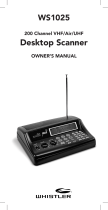
Introduction
2
+0641&7%6+10
Your new RadioShack PRO-82
200 Channel VHF/Air/UHF
Handheld Scanner lets you scan
conventional transmissions, and is
preprogrammed with search
banks for convenience. By
pressing a one touch search key,
you can quickly search those
frequencies most commonly used
by public service and other
agencies without tedious and
complicated programming.
This scanner gives you direct
access to over 25,000 exciting
frequencies, including those used
by police and fire departments,
ambulance services, aircraft, and
amateur radio services, and you can
change your selection at any time.
Your scanner also has these
special features:
Ten Channel-Storage Banks
—
you can store 20 channels in each
bank (200 total channels), letting
you group channels so you can
more easily identify calls.
Weather Alert
— the scanner
automatically sounds an alert
when it receives a weather
emergency signal, providing more
complete information about
weather conditions in your
immediate area.
HyperSearch
™
and
HyperScan
™
— let you set the
scanner to search at up to 50
steps per second (in frequency
bands with 5 kHz steps) and scan
at up to 25 channels per second,
to help you quickly find interesting
broadcasts.
%106'065
Introduction ............ 2
The FCC Wants You
to Know ................. 4
Scanning
Legally .............. 5
Preparation ............ 7
Installing
Batteries ........... 7
Charging
Rechargeable
Batteries ........... 8
Using
AC Power ......... 9
Using Vehicle
Battery
Power ............. 10
Connecting the
Supplied
Antenna .......... 10
Connecting an
Earphone/
Headphones ... 11
Connecting an
Extension
Speaker .......... 12
Using the
Belt Clip .......... 12
About Your
Scanner ............... 13
A Look at the
Keypad ................ 14
A Look at the
Display ................. 15
#
"+/2146#06"#
If an icon appears at
the end of a
paragraph, go to the
box on that page with
the corresponding
icon for pertinent
information.
Rý
—
Warning
#
—
Important
.
..
.
—
Caution
°
°°
°
—
Hint
±
— Note
20-315.fm Page 2 Wednesday, July 24, 2002 2:27 PM




















